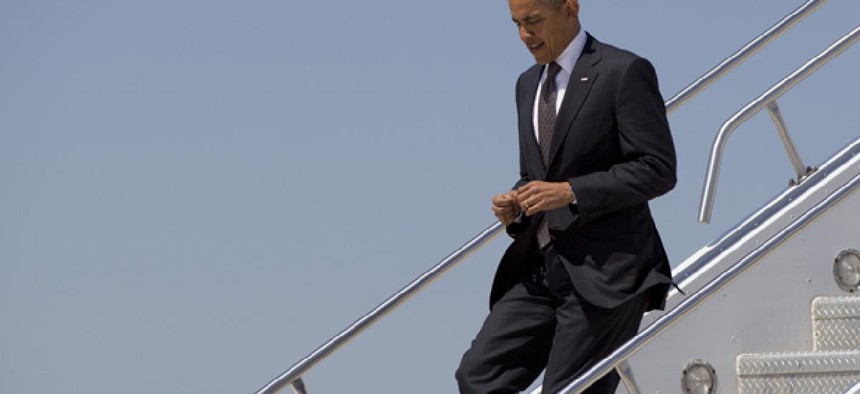
Carolyn Kaster/AP
Trouble for Obama
Dig into the polling numbers and you'll find some warning signs for the president heading into the general election.
Gallup has now finished its first six full weeks of tracking surveys for the 2012 presidential campaign, interviewing 20,565 registered voters. Yes, you guessed it: President Obama and Mitt Romney are tied, 46 percent to 46 percent. The margin of error for a sample of this size is just under seven-tenths of a percentage point; Gallup, though, modestly reports it at +/- 1 percent, for the sake of simplicity. One benefit of a poll this size is that it allows you to look at demographic subgroups of voters without worrying about big margins of error. So when you get a chance to look at “supersized” data, grab it.
Each day at 1 p.m., Gallup.com reports the three-day moving average for Obama’s job-approval rating. At the same time, it also reports the seven-day moving average for the presidential-election trial heat between Obama and Romney, the presumptive Republican nominee, by averaging more than 3,000 interviews a week. Each Monday afternoon, the Princeton, N.J.-based granddaddy of polling firms reports detailed demographic breakdowns for the combined most recent three weeks of interviewing. This week, Gallup released six full weeks of results. The first half of these were interviews between April 11 and May 6; the second half were from May 7 through May 27. (It’s a good thing that I am not addicted to this stuff.)
The gender splits were almost perfectly symmetrical in the two batches. Among women, Obama led Romney by 7 points, 49 percent to 42 percent, in the first three weeks, and by 8 points, 50 percent to 42 percent, in the second. Among men, Romney had an 8-point lead, 50 percent to 42 percent, in both the front and back halves of the six weeks of interviewing. If you recall, in 2008, the exit polls showed that Obama edged Sen. John McCain by 1 point among men, 49 percent to 48 percent. Among women, he beat McCain by a whopping 13 points, 56 percent to 43 percent. Among white males, Romney had leads of 27 points in the first three weeks (59 percent to 32 percent), and 25 points in the second (59 percent to 34 percent). Among white females, though, the Romney advantage was considerably narrower: a 9-point lead, 50 percent to 41 percent, in each half.
If you think of politics as a tennis game, each candidate is holding his serve nicely. Obama won the support of 88 percent of Democrats in both the front and back halves of the six weeks of tracking; Romney won just 7 percent of Democrats in the front and 8 percent in the back. Among Republicans, Romney won 89 percent in the front half and 90 percent in the back half. Obama pulled 7 percent of Republicans in both three-week periods.
Independents split down the middle; Romney edged Obama by 1 point in the front half, 43 percent to 42 percent, and by 2 points in the second, 43 percent to 41 percent. The percentage of partisans that Obama and Romney are holding is pretty typical. The fact that independents are splitting pretty much down the middle suggests an election a lot more like the close ones in 2000 and 2004 than like 2008, when Obama carried the independent vote by 8 percentage points, 52 percent to 44 percent, and the overall election by 7 points.
Not surprisingly, Obama is winning the African-American vote by gargantuan proportions: 90 percent to 5 percent in the first half of the survey and 88 percent to 6 percent in the second, not far off his 2008 showing (95 percent to 4 percent). Among Hispanic voters, Obama’s margins were also very similar to his level four years ago. He led 68 percent to 23 percent in the first three weeks of tracking and 65 percent to 25 percent in the second. In the 2008 exit polls, Obama beat McCain 67 percent to 31 percent among Hispanics. Among non-Hispanic white voters, Romney romped by 17 points in the first three weeks, 54 percent to 37 percent, and by 16 points in the more recent three weeks, 54 percent to 38 percent.
The important caveat is propensity to vote. Gallup asked registered voters to rate, on a 10-point scale, how likely they were to vote in November. Eighty-one percent and 82 percent of non-Hispanic whites indicated 10. For African-Americans, it was almost as high: 79 percent and 75 percent chose 10. Among Hispanics, though, just 58 percent in the front half and 65 percent in the second half put their propensity to vote at 10.
This data suggest that Obama is on track to replicate his performances in terms of support among African-Americans and Hispanics. The Hispanic-turnout problem, though, is very real.
The most striking poll finding was the generational divide among white voters. Among whites 18 to 29, Romney led by 3 points in the first three weeks of interviewing; Obama had a 1-point edge in the second three weeks. Among whites 30 and older, the Romney advantage ballooned to 19 points in the first half and 20 points in the second. But it’s the likelihood of voting that should worry Democrats: 84 and 85 percent of those 30 and older said their likelihood of voting was 10; only 61 and 63 percent of those 18 to 29 indicated 10.
On one level, the presidential election is a fight for the hearts and minds of independents in the middle. For the Obama campaign, though, the second fight is to get young and Hispanic voters to show up. The intensity of four years ago is hard to find today.
NEXT STORY: Erupting urinal soaks House press gallery






